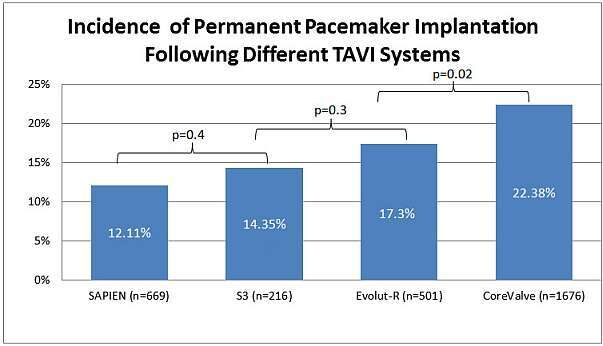
Post TAVI Permanent Pacemaker Implantation in First Versus Second Generation Transcatheter Heart Valves: Data from the Israeli Multicenter TAVI Registry
2Sackler School of Medicine, Tel-Aviv University
3Cardiology, Sheba Medical Center
4Cardiology, Tel-Aviv Medical Center
5Cardiology, Rabin Medical Center
Background: Transcatheter aortic valve implantation (TAVI) is an alternative for surgical replacement of the aortic valve in patients with severe symptomatic aortic stenosis. The need for permanent pacemaker implantation (PMKI) after TAVI was previously associated with poor outcome. Second generation TAVI systems design was aimed at incidence reduction of this and other adverse events. We explored the incidence of post-TAVI PMKI in two TAVI system generations.
Methods: This retrospective analysis utilized a prospective collection of data from four large-volume TAVI center in Israel. Data related to the pre-procedural, procedural and post-procedural follow-up was collected and analyzed. Included were patients that underwent TAVI with balloon expandable valve (Edwards’ SAPIEN (1st generation) or S3 (2nd generation)) and self-expandable valve (Medtronic CoreValve (1st generation) or Evolut-R (2nd generation). A comparison between the incidences of PMKI was performed between each of the valve generations.
Results: Included were 2,561 patients that underwent TAVI Between 2008-2016. Of them, 885 (34.5%) underwent TAVI with balloon expandable valve while the rest had self-expandable TAVI. The mean age was 82.17±6.7 years with 45% of male gender. The incidence of PMKI did not differ between SAPIEN and S3 (12.1% vs. 14.3%;p=0.4). PMKI incidence was lower in the Evolut R compared with CoreValve (17.3% vs. 22.3%;p=0.02). No significant difference in PMKI incidence was recorded between S3 and Evolut-R (14.3% vs. 17.3%;p=0.3).
Conclusions: PMKI remains an important adverse event after TAVI. Second generation self-expandable valve demonstrated lower incidence than its predecessor with comparable incidence to the balloon expandable valve.


Powered by Eventact EMS